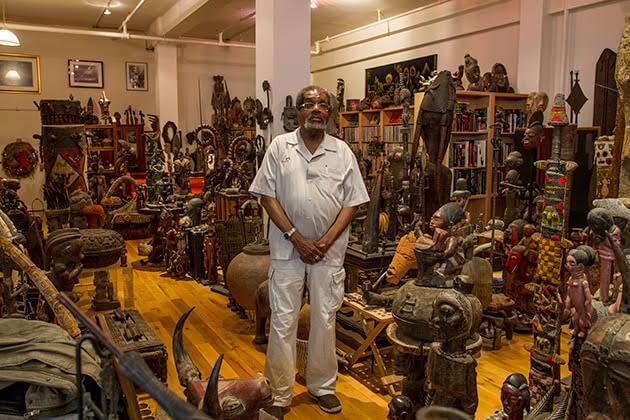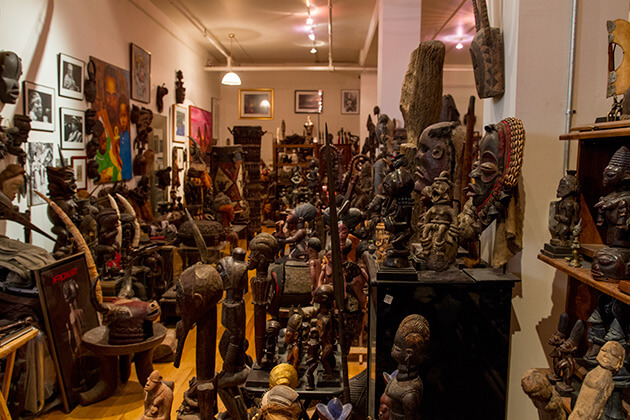“While his … collection of African art borders on the fringes of compulsion, especially considering the lengths he’s gone to acquire certain works, Edwards is more like an archaeologist searching for missing links than a collector looking to profit.”
~ Sam Blum, Journalist
Born and reared in the Brooklyn borough of New York City, Eric Edwards has spent more than five decades curating one of the greatest private collections of African art in the world. Critical in his mission to educate others about the richness and vibrant truths of African culture, the septuagenarian has acquired more than 2,500 artifacts. His collection includes art, ceremonial pieces, instruments, statues, masks and weaponry.

(No copyright infringement intended).
His pieces have been acquired from his professional and personal travels, private sales, auctions and relationships with artists, artisans, gallery owners and even royal families throughout Africa. Among these items is a one-of-a-kind, palace drum of Nigeria that is valued at an estimated $1 million. Some of his pieces have been exhibited in prestigious cultural institutions, including the Metropolitan Museum of Art.
One of these pieces is a weaving from Cameroon. In “Inside the Bed-Stuy Home of Eric Edwards and His $10 Million-Collection of African Art” by Sam Blum for Brooklyn, the writer learns of the process it took for Edwards to acquire the piece. In his article, Blum wrote that “a royal family performed a passage of rights to formally grant him ownership of the object, which had originally belonged to a tribal chief. The ceremony didn’t take place in Cameroon however, but right in his apartment in Brooklyn, next to his kitchen.” Blum learned that the chief dispatched, according to Edwards, “emissaries here to Brooklyn with the piece, totally enshrouded in a special casing, which they had to unwrap. Then there was a special ceremony that they conducted in the Bamileke language.”
A retired executive and consultant with AT&T, he shares his collection with the public. One of Edwards’ primary interests is to have it contained within its own museum, which is to be named “The Cultural Museum of African Art”, located in the Bedford-Stuyvesant area of Brooklyn. The selection of his home borough to house his massive collection, which spans more than four thousand years and is representative of all fifty-four countries in Africa, is only natural.
Not only is Brooklyn where he has spent most of his life but it contains a large population of persons of African descent. Architect Rodney Leon, whose design work includes the African Burial Ground which is also in New York City, shares Edwards’ desired site selection. In “New York’s Eric Edwards, Who Owns a $10 Million Collection, Works to Open African Art Museum” by Jennie Matthew in ArtDaily, Leon affirms, “If it takes a couple of extra years to get the museum right I think it’s worth it … It would be an amazing opportunity to put something like this in Brooklyn and to have it really accessible to the local population.”
Born to James and Eleanor Edwards, Eric is one of the couple’s three children; his siblings are Milton and Myrna. James, a native of Barbados, immigrated to the United States during the 1930s when he was only eighteen years old. He sought greater opportunities of personal success. However, the pervasive and intense racism and discrimination he experienced in his new homeland were shocking. When he became a parent, James wanted to enlighten and prepare his children for the lies and cruelties all too often thrusted upon and sanctioned against Blacks.
According to Eric in “Kenya Believe It? African Art Collector’s $10 Million Urban Hoard” by John Balson at Truly/The New Home of bTV website, James personally taught his children of their heritage “because of the racism he knew his children would encounter were the same as we entered the public school system.” He further emphasized the effect of his father on him in the Brooklyn article. In it, the collector proudly stated that James Edwards wanted to “inoculate us from racism so we would always be proud of ourselves, know where we came from and know that we can accomplish whatever we wanted to.”
His father’s cultural instruction provided the Edwards children with a strong sense of identity, shared Africa Diaspora ties and great pride. The development of a museum would allow Eric Edwards to educate and inspire others, especially in light of the past several years in which many African Americans have suffered great and tragic indignities, injustices, violence and even murder. Edwards speaks to the positive impact of his collection in the ArtDaily article. He proffered, “We are at an impasse, for sure, as far as connectivity and communication between the races and appreciation of the races … I can’t see a better way to bring people together than through the appreciation of the African artifacts and the stories that they tell.”
A group that he; his sister, Myrna; city officials and many other supporters worldwide believe would significantly benefit from Edwards’ collection are children. Edwards, who lives alone, wants his collection to be experienced, respected and appreciated long after he passes. There are two ways that this could occur; the first would be the development of a cultural institution and the other are the youth. Edwards, as shared to Blum, feels “that giving African-American kids a window into their cultural past will inevitably translate into ‘a greater sense of self-respect and motivation … and it’s going to make them better citizens and contributors to society, and we really need that.’”
Myrna Edwards-Williams, a retired school administrator, could create the curriculum for his extensive collection. In the Brooklyn piece, she further expounds that her brother has always been a collector. Blum wrote that she “invokes memories of Eric fiddling with things like Lionel Trains and baseball cards as a boy, only to find him polishing dust off a massive shelf packed with 40,000 LPs as a man.” In the article, Edwards-Williams shared that her brother’s collection would “make a difference in the lives of children and adults of all ethnicities … I know what it can do for kids, it can change them once they start knowing who they are and where they came from.”
Ron Fields shares the sentiment of the Edwards brother and sister. The president and executive director of Weeksville Heritage Center, which featured an exhibition sourced from Edwards’ collection in 2018, provided insight in “One of the Largest Private Collections of African Art Opens in Weeksville” by Andrea Leonhardt on the BK Reader website. In the piece, Fields praised, “We are constantly thinking about how to connect past to present in ways that are relevant and resonant for our community. Given the current tenor of the times, it’s hard to imagine few things more powerful and reaffirming than a Black cultural institution hosting and highlighting African art that’s been collected and curated by someone in our community.”
Presently, his collection, whose worth is valued in the millions, is housed in his actual home in Bedford-Stuyvesant. In the Brooklyn article, Blum described, “Eric Edwards lives on an unassuming street lined with tall, red-brick buildings … His own building is otherwise innocuous and lends itself to no more rumination than any neighboring apartment complex. But inside this building, and in his very apartment, Edwards stows an estimated $10 million collection of African art and tribal artifacts. His collection sprawls so densely across the floor, it’s as if it is part of it, growing from the ground beneath. The effect is impressive, if somewhat jarring; the smooth and jagged contours of his sculptures, drums, tools, weapons and weavings careen towards the ceiling like breaking waves in a choppy current. To walk through this living room is to experience generations of African history, and you’d be a fool if you weren’t anxious about breaking a piece worth more than your yearly salary.”

(No copyright infringement intended).
Measures he has taken to develop the museum include initiating a Kickstarter campaign as well as exhibiting pieces and curating his own exhibition, such as at Weeksville. That 2018 exhibition included fifty items from seventeen African countries. According to Leonhardt, the artifacts included “a 4,000-year-old royal woman granite bust from the Nubian empire; a bronze flute player illustrating the “Lost-Wax” method of casting created in Africa; ancient craftsmen’s tools utilized to create the art; shrine pieces from Gabon, the Congo and South Africa; drums of the Baga of Guinea and the Yangere of the Congo; as well as rare African and U.S. slave chains that document the Trans-Atlantic Slave Trade.”
This exhibit illustrated the resilience of Africa Diaspora ties that influenced the beliefs and practices of Blacks who would survive and thrive beyond the brutal system of slavery in America. Their faith, endurance, commitment and efforts led to greatness in both preserving their ancestral ties and creating new aspects of culture and life. One of these aspects is development of communities, such as Weeksville, one of the earliest, free Black communities in the United States.
The committed passion and dedicated work of Eric Edwards is incredibly enlightening and empowering. Wherever his collection is housed, the minds, hearts and spirits of its visitors are sure to be enhanced and encouraged!
“I don’t think that there is enough pride in African heritage in America and that’s not due to any fault of African Americans.”
~ Eric Edwards




